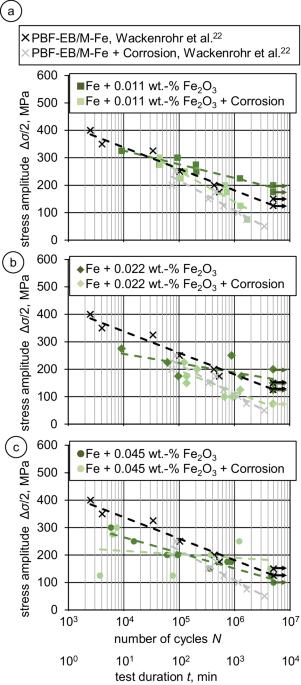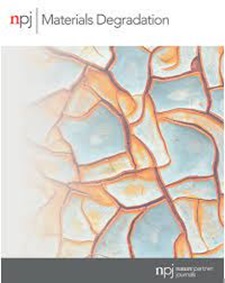Corrosion fatigue behavior of nanoparticle modified iron processed by electron powder bed fusion
IF 7.6
2区 材料科学
Q1 MATERIALS SCIENCE, MULTIDISCIPLINARY
引用次数: 0
Abstract
Due to its excellent biocompatibility, pure iron is a very promising implant material, but often features corrosion rates that are too low. Using additive manufacturing and modified powders the microstructure and, thus, the material properties, e.g., the corrosion properties, can be tailored for specific applications. Within the scope of this study, pure iron powder was modified with different amounts of CeO2 or Fe2O3 nanoparticles and subsequently processed by Electron Beam Powder Bed Fusion (PBF-EB/M). The corrosion-fatigue behavior of CeO2 and Fe2O3 modified iron was investigated using rotation bending tests under the influence of simulated body fluid (m-SBF). While the modification using Fe2O3 showed reduced fatigue and corrosion-fatigue strengths, it could be demonstrated that the modification with CeO2 is characterized by improved fatigue properties. The superior fatigue properties in air are attributed to the positive impact of dispersion strengthening. Additionally, an increased degradation rate compared to pure iron could be observed, eventually promoting an earlier failure of the specimens in the corrosion fatigue tests.

电子粉末床熔融法加工的纳米粒子改性铁的腐蚀疲劳行为
由于具有良好的生物相容性,纯铁是一种非常有前途的植入材料,但其腐蚀率往往过低。利用增材制造和改性粉末,可以针对特定应用定制微观结构和材料特性,例如腐蚀特性。在本研究范围内,用不同数量的 CeO2 或 Fe2O3 纳米颗粒对纯铁粉进行了改性,然后用电子束粉末床熔融(PBF-EB/M)进行加工。在模拟体液(m-SBF)的影响下,采用旋转弯曲试验研究了 CeO2 和 Fe2O3 改性铁的腐蚀疲劳行为。虽然使用 Fe2O3 进行改性会降低疲劳强度和腐蚀疲劳强度,但可以证明使用 CeO2 进行改性具有更好的疲劳性能。在空气中的优异疲劳性能归功于分散强化的积极影响。此外,与纯铁相比,可观察到降解率增加,最终导致试样在腐蚀疲劳试验中提前失效。
本文章由计算机程序翻译,如有差异,请以英文原文为准。
求助全文
约1分钟内获得全文
求助全文
来源期刊

npj Materials Degradation
MATERIALS SCIENCE, MULTIDISCIPLINARY-
CiteScore
7.80
自引率
7.80%
发文量
86
审稿时长
6 weeks
期刊介绍:
npj Materials Degradation considers basic and applied research that explores all aspects of the degradation of metallic and non-metallic materials. The journal broadly defines ‘materials degradation’ as a reduction in the ability of a material to perform its task in-service as a result of environmental exposure.
The journal covers a broad range of topics including but not limited to:
-Degradation of metals, glasses, minerals, polymers, ceramics, cements and composites in natural and engineered environments, as a result of various stimuli
-Computational and experimental studies of degradation mechanisms and kinetics
-Characterization of degradation by traditional and emerging techniques
-New approaches and technologies for enhancing resistance to degradation
-Inspection and monitoring techniques for materials in-service, such as sensing technologies
 求助内容:
求助内容: 应助结果提醒方式:
应助结果提醒方式:


